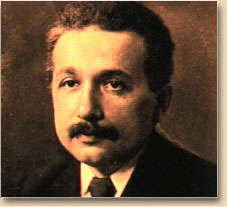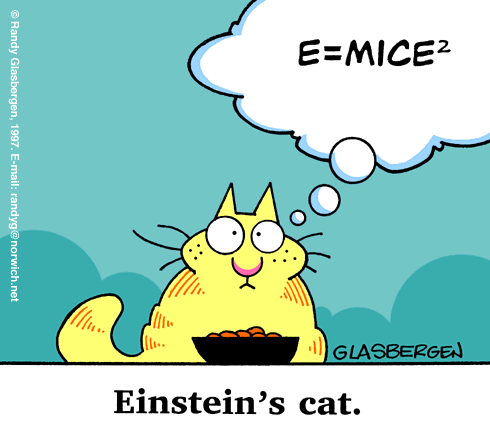
Special Relativity proposed that distance and time are not absolute. The ticking rate of a clock depends on the motion of the observer of that clock; likewise for the length of a "yard stick." Published in 1915, General Relativity proposed that gravity, as well as motion, can affect the intervals of time and of space. The key idea of General Relativity, called the Equivalence Principle, is that gravity pulling in one direction is completely equivalent to an acceleration in the opposite direction. (A car accelerating forwards feels just like sideways gravity pushing you back against your seat. An elevator accelerating upwards feels just like gravity pushing you into the floor. If gravity is equivalent to acceleration, and if motion affects measurements of time and space (as shown in Special Relativity), then it follows that gravity does so as well. In particular, the gravity of any mass, such as our sun, has the effect of warping the space and time around it. For example, the angles of a triangle no longer add up to 180 degrees and clocks tick more slowly the closer they are to a gravitational mass like the sun. Many of the predictions of General Relativity, such as the bending of starlight by gravity and a tiny shift in the orbit of the planet Mercury, have been quantitatively confirmed by experiment. Two of the strangest predictions, impossible ever to completely confirm, are the existence of black holes and the effect of gravity on the universe as a whole (cosmology).
![]()
![]()
![]()
![]()
A black hole is a region of space whose attractive gravitational force is so intense that no matter, light, or communication of any kind can escape. A black hole would thus appear black from the outside. (However, gas around a black hole can be very bright.) It is believed that black holes form from the collapse of stars. As long as they are emitting heat and light into space, stars are able to support themselves against their own inward gravity with the outward pressure generated by heat from nuclear reactions in their deep interiors. Every star, however, must eventually exhaust its nuclear fuel. When it does so, its unbalanced self gravitational attraction causes it to collapse. According to theory, if a burned- out star has a mass larger than about three times the mass of our sun, no amount of additional pressure can stave off total gravitational collapse. The star collapses to form a black hole For a non rotating collapsed star, the size of the resulting black hole is proportional to the mass of the parent star; a black hole with a mass three times that of our sun would have a diameter of about 10 miles. The possibility that stars could collapse to form black holes was first theoretically "discovered" in l939 by J. Robert Oppenheimer and H. Snyder, who were manipulating the equations of Einstein's General Relativity. The first black hole believed to be discovered in the physical world, as opposed to the mathematical world of pencil and paper, was Cygnus X-1, about 7000 light years from earth. (A light year, the distance light travels in a year, is about six trillion miles.) Cygnus X-1 was found in 1970. Since then, a dozen excellent black hole candidates have been identified. Many astronomers and astrophysicists believe that massive black holes, with sizes up to ten million times that of our sun, inhabit the centers of energetic galaxies and quasars and are responsible for their enormous energy release. Ironically, Einstein himself did not believe in the existence of black holes, even though they were predicted by his theory. Beginning in 1917, Einstein and others applied General Relativity to the structure and evolution of the universe as a whole. The leading cosmological theory, called the Big Bang theory, was formulated in 1922 by the Russian mathematician and meteorologist Alexander Friedmann. Friedmann began with Einstein's equations of General Relativity and found a solution to those equations in which the universe began in a state of extremely high density and temperature (the so- called Big Bang) and then expanded in time, thinning out and cooling as it did so. One of the most stunning successes of the Big Bang theory is the prediction that the universe is approximately ten billion years old, a result obtained from the rate at which distant galaxies are flying away from each other. This prediction accords with the age of the universe as obtained from very local methods, such as the dating of radioactive rocks on the earth. According to the Big Bang theory, the universe may keep expanding forever, if its inward gravity is not sufficiently strong to counterbalance the outward motion of galaxies, or it may reach a maximum point of expansion and then start collapsing, growing denser and denser, gradually disrupting galaxies, stars, planets, people, and eventually even individual atoms. Which of these two fates awaits our universe can be determined by measuring the density of matter versus the rate of expansion. Much of modern cosmology, including the construction of giant new telescopes such as the new Keck telescope in Hawaii, has been an attempt to measure these two numbers with better and better accuracy. With the present accuracy of measurement, the numbers suggest that our universe will keep expanding forever, growing colder and colder, thinner and thinner. General relativity may be the biggest leap of the scientific imagination in history. Unlike many previous scientific breakthroughs, such as the principle of natural selection, or the discovery of the physical existence of atoms, General Relativity had little foundation upon the theories or experiments of the time. No one except Einstein was thinking of gravity as equivalent to acceleration, as a geometrical phenomenon, as a bending of time and space. Although it is impossible to know, many physicists believe that without Einstein, it could have been another few decades or more before another physicist worked out the concepts and mathematics of General Relativity.

